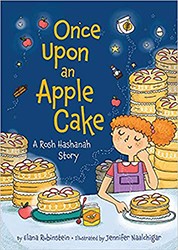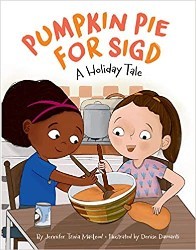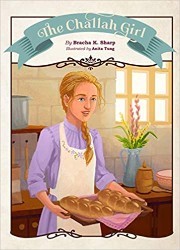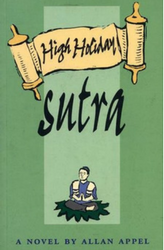Picture books about Purim usually focus on either its Biblical source or on the festive customs associated with the holiday’s observance. Sweet Tamales for Purim is in the second category but with the surprising twist of going back to American history for a less familiar setting. The story takes place in late nineteenth-century Tucson, Arizona, where a small Jewish community maintained its own customs for Purim while also interacting with their non-Jewish neighbors. In Bietz’s telling, a young girl, Rebecca, has carefully prepared the traditional hamantaschen with the help of her friend, Luis. When her family’s goat, Kitzel, overturns the tray of pastries, it appears that the holiday has been ruined. Rebecca’s happily resolved adventure offers readers a glimpse into the past of Jews in the southwest, as the kindness and support of her community save the Purim Ball.
Bietz establishes on the first page that Purim is open to everyone in Rebecca’s small town. The simple narrative and straightforward language describe a different world, one where “Some folks were traveling by horse and buggy, some by train” to the town’s famed celebration. Historical details, from antique modes of transportation to writing on slate boards, are featured. Rebecca outlines the basics of Purim’s history and observance to her friend whose “family celebrates different holidays from mine.” Luis’s Christianity and his Mexican heritage are incidental to their friendship and the diversity of the book’s characters is unremarkable, a normal part of life in the region. The book’s target audience of young children will enjoy the story’s simplicity, as well as its positive message of cooperation and harmony.
When a discouraged Rebecca visits Luis’s home, his mother finds a practical solution to the loss of the hamantaschen. Avoiding explanations of culinary difference, this kind and practical mother guides her son and his friend in baking an alternative: sweet tamales. By listing the ingredients and describing the preparation, the author involves readers in the preparation of a novel Purim dish. The parallels between Rebecca and Luis’s homes, where both mothers offer encouragement, convey the essential values which Rebecca and her neighbors hold in common. The children are also proud of their accomplishment having “saved Purim” for everyone expecting a joyous event.
Kanzler’s illustrations feature bright colors and authentic elements of the book’s time and place. His domestic interiors are the most successful pictures, with Rebecca and Luis assembling corn husks and cinnamon to make the tamales, as well as the simple chalk-drawn scenes of Queen Esther which Rebecca uses to teach her friend about Jewish history. A picture of Rebecca tilting her head back as she swings a Purim grogger shows her absorbed in its sound and a scene of Luis’s mother carefully lifting a pot of tamales from a cast iron stove feels authentic. Both images, like the rest of the book, invite readers to experience Jewish traditions in a different and relevant context of cultural exchange.
An “Author’s Note” is included which explains the history behind the story.
Emily Schneider writes about literature, feminism, and culture for Tablet, The Forward, The Horn Book, and other publications, and writes about children’s books on her blog. She has a Ph.D. in Romance Languages and Literatures.






